Key takeaways:
- Fauvism is characterized by bold colors and simplified forms, prioritizing emotional expression over realistic representation.
- Key artists like Henri Matisse and André Derain significantly shaped the movement with their innovative use of color and energetic brushwork.
- Techniques such as layering colors and simplifying forms are essential for expressing the emotional resonance typical of Fauvism.
- Displaying Fauvist art effectively enhances viewer experience through strategic placement and optimal lighting to highlight the vibrancy of colors.
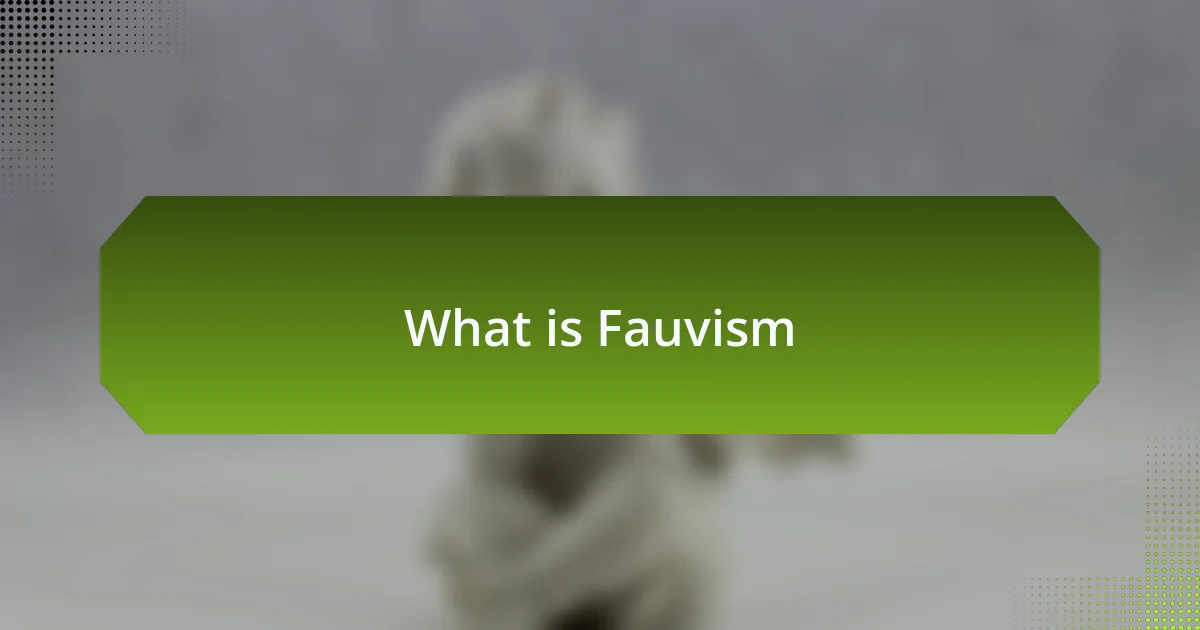
What is Fauvism
Fauvism, emerging in the early 20th century, is often characterized by its bold use of color and simplified forms. This movement, led by artists like Henri Matisse and André Derain, focused on expressing emotion rather than representing reality accurately. I find it fascinating how they believed color could convey feeling, even more than the subject itself.
When I first encountered Fauvism, the vibrancy of the colors literally stopped me in my tracks. It felt as though each brushstroke was shouting rather than just whispering the artist’s intention. Have you ever felt overwhelmed by vivid colors in a painting? That immediate emotional response is exactly what the Fauves aimed to provoke. It’s arguably a rebellion against the restrained palettes and realist techniques that preceded them.
In Fauvism, the artists prioritized personal expression, often using unconventional combinations of colors. For instance, in Matisse’s works, you might see a serene blue sky next to a fiery red landscape. This juxtaposition invites us to question how color influences our feelings about the world. Isn’t it intriguing how the same scene can evoke different emotions depending on the hues used? This is what makes Fauvism so special; it turns colors into a universal language of expression.
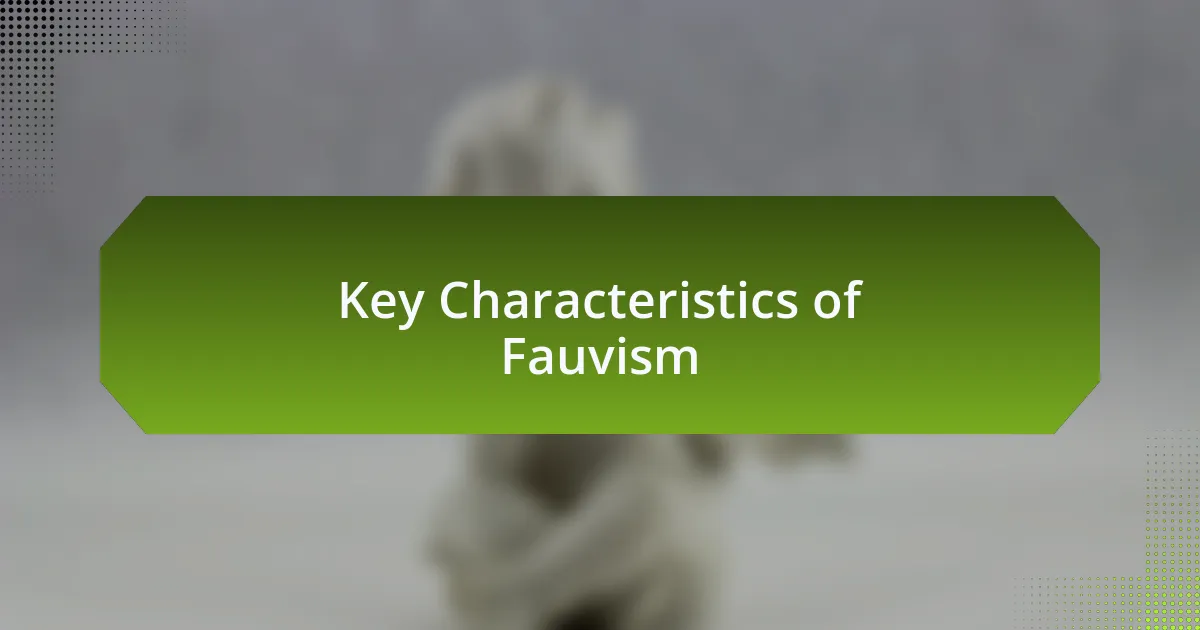
Key Characteristics of Fauvism
Fauvism’s key characteristics revolve around the vivid, expressive use of color, which is unapologetically non-representational. When I look at a Fauvist painting, I often feel as if the colors are conversing with me, breaking the barriers of conventional representation. The thrill of seeing bright oranges and greens side by side makes me ponder: how can something so bold provoke such a variety of emotional responses?
Another defining trait is the emphasis on brushwork and texture. The visible, energetic brushstrokes in a Fauvist piece breathe life into the canvas, creating an almost tactile experience. I recall standing in front of a Matisse painting, feeling as though I could reach out and grasp the texture—each stroke felt personal, inviting me into the artist’s world. Isn’t it amazing how a simple stroke of paint can carry the weight of a thousand emotions?
Moreover, Fauvism breaks away from traditional perspectives and anatomical precision. In works like those of André Derain, shapes may be distorted, yet they resonate with an underlying emotional truth. I often appreciate how these distortions encourage me to engage with the artwork on a deeper level, prompting reflection. Have you ever noticed how a seemingly simple composition can evoke profound thoughts? The Fauves understood that art isn’t just about representation; it’s about awakening something within us through the sheer power of color and form.
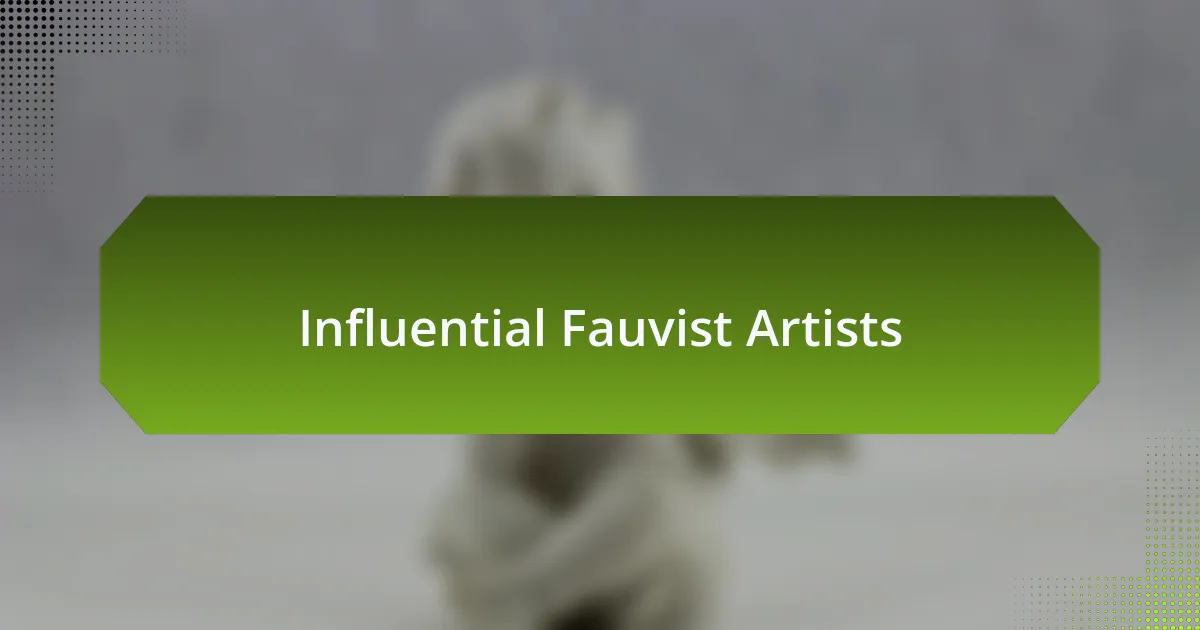
Influential Fauvist Artists
When discussing influential Fauvist artists, Henri Matisse stands out as a pivotal figure. His use of color was revolutionary, transforming ordinary scenes into vibrant, emotional landscapes. I remember my first encounter with “Woman with a Hat” and how the unconventional hues captivated me, pulling me into a world where expression reigns supreme. Don’t you find it fascinating how Matisse’s colors can evoke such strong feelings?
Another key artist is André Derain, who alongside Matisse, helped define the Fauvist movement. Eagerly experimenting with color and composition, his paintings radiate an almost infectious energy. I once admired “Charing Cross Bridge” and felt the energetic brushstrokes vibrate off the canvas, beckoning me to explore the urban scene anew. It made me wonder, can a painting truly convey the pulse of a city just through color?
Lastly, we cannot overlook Maurice de Vlaminck, who brought intensity and fervor to Fauvism with his thick application of paint. His striking work “The River Seine at Chatou” left me enchanted with its luscious color palette and dynamic forms. As I stood before it, I realized how he skillfully captured a moment in nature while also infusing it with raw emotion. How does one explain that blend of reality and sentiment captured on canvas? That’s part of the magic of Fauvism.
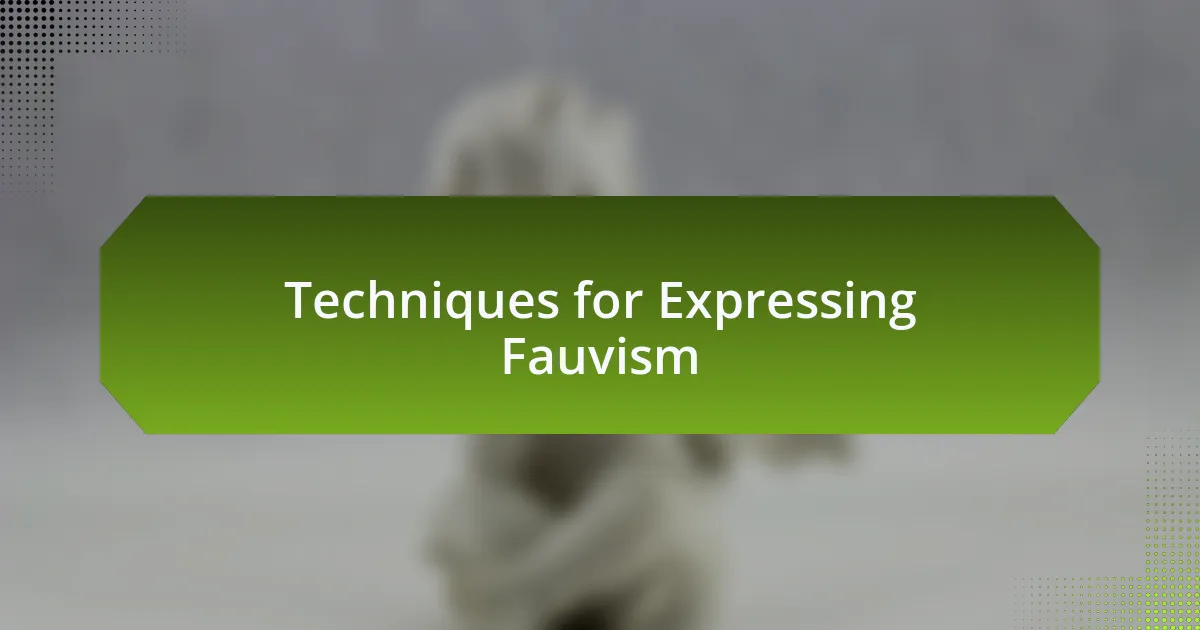
Techniques for Expressing Fauvism
To express Fauvism effectively, one must embrace bold colors that resonate emotionally rather than conforming to the realistic palette. I vividly recall a moment when I painted a still life using a riot of reds and oranges instead of the traditional browns and greens. The reaction was immediate and powerful; it sparked a conversation about the feeling of warmth and vibrancy, rather than simply depicting what was in front of me. Isn’t it remarkable how a color choice can shape an entire narrative?
Another essential technique is the energetic application of paint. I often find myself layering colors with a palette knife, creating a tactile experience that draws viewers closer. One time, while experimenting with this approach, I felt my brushstrokes pulse with life, almost like I was dancing on the canvas. Don’t you think that this kind of movement captures a deeper essence of the subject?
Lastly, simplifying forms can lead to profound expressions in Fauvism. During one of my creative sessions, I decided to reduce a landscape to its most basic shapes, using color to convey depth and emotion. The result was a piece that felt almost like a dream, and it prompted viewers to share their interpretations of the scene. How incredible is it that abstraction can evoke such personal connections?
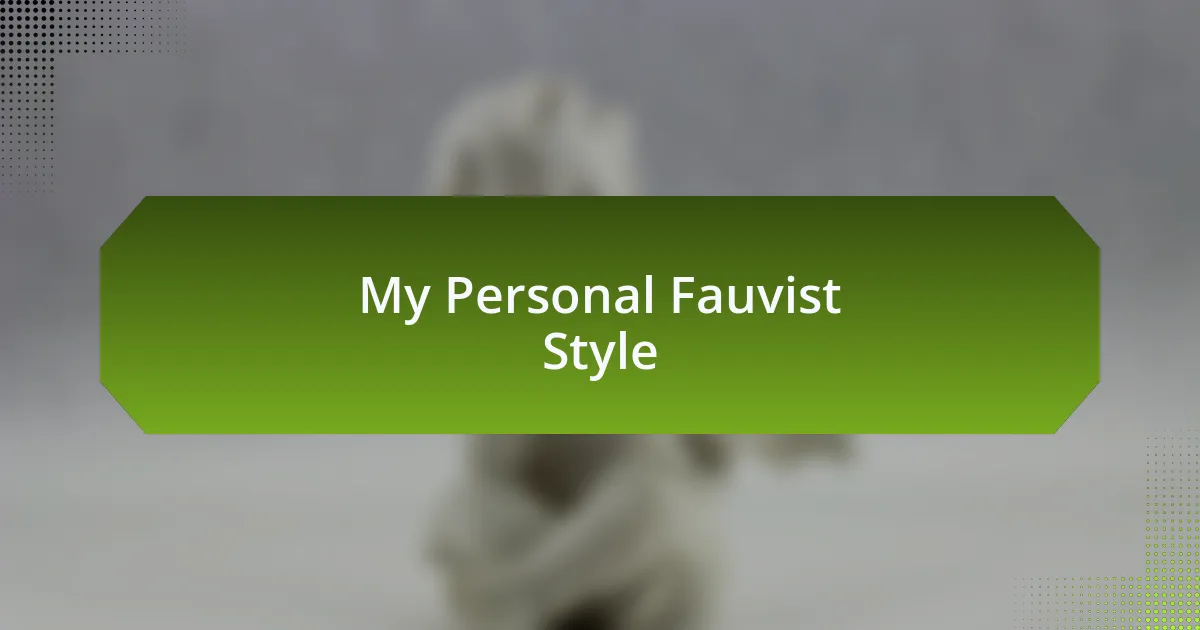
My Personal Fauvist Style
When it comes to my personal Fauvist style, the heart of my expression lies in the emotional resonance of color. I remember a particular piece where I took a familiar scene from my childhood—a bustling market—and drenched it in electric blues and greens. The colors felt alive, and as I painted, I was reminded of the excitement and chaos of that market, transporting both me and viewers back to that vivid memory. Isn’t it exhilarating how color can act as a time machine for our emotions?
I also embrace spontaneity in my process. One afternoon, with music pulsing in the background, I let my instincts guide my brush. Instead of meticulously planning each stroke, I splashed paint onto the canvas without a clear vision, which led to unexpected forms and vibrant interactions. That day, I realized that by surrendering to the unpredictability of creation, I open myself to raw expression. How often do we limit our creativity by overthinking our actions?
In Fauvism, I find freedom through the abstraction of forms, allowing me to express my personal perceptions rather than the literal truth. In a recent artwork, I focused on a simple tree, transforming it into a swirling array of colors and shapes that captured my emotional response to nature. The result ignited conversations about what the tree represented to each viewer, showing me that simplicity can unlock complex narratives. Isn’t it fascinating how stripping away the details can make space for deeper connections?
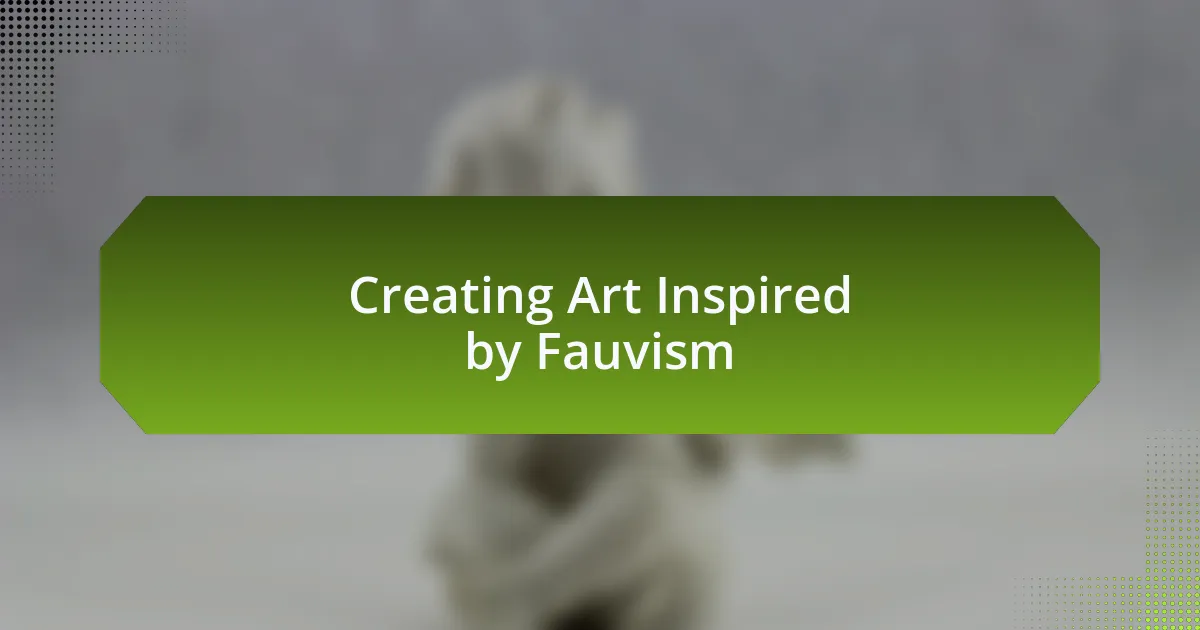
Creating Art Inspired by Fauvism
Creating art inspired by Fauvism is a journey into the vibrant spectrum of emotion. I remember one project where I decided to experiment with a palette of fiery reds and yellows to reflect my feelings on a particularly passionate day. As I applied the paint, I felt a surge of energy, almost as if I was channeling my inner flame onto the canvas. Have you ever felt so alive that your art seems to pulse with your heartbeat?
The process of layering colors has also become a favorite technique of mine. Each layer tells a story and represents a different feeling or thought. In one piece, I built my canvas up with bold strokes of cerulean and magenta, creating a dialogue between the colors. This layering not only adds depth but also mirrors the complexities of our emotions—how often do our feelings intertwine, just like colors on a canvas?
I truly believe that spontaneity is essential in creating Fauvist-inspired art. One morning, while watching the sun rise, I grabbed my brushes and started painting the scene without any hesitation. The result was a delightful chaos of orange and purple swirls that didn’t quite resemble the dawn, yet captured the essence of my awe. Isn’t it remarkable how allowing yourself to break free from conventions can lead to such exhilarating outcomes?

Displaying Fauvist Art in Galleries
Displaying Fauvist art in galleries is an exhilarating experience that invites viewers into a world of color and emotion. I vividly recall my visit to a local gallery that hosted a Fauvist exhibition, where the walls exploded with vibrant hues that seemed to dance before my eyes. How do you think it feels to be enveloped in such an immersive display of artistry?
The layout of the gallery can significantly enhance the viewing experience of Fauvist works. I once noticed how strategically placing bold paintings next to softer pieces can create a thrilling contrast. It’s as if the gallery breathes life into the emotion of each artwork, enabling visitors to feel the artist’s intent even more deeply. Have you ever noticed how the flow of colors can guide your mood as you move through a space?
Lighting is another crucial element in showcasing Fauvist art. I remember a particular exhibition where natural light flooded the room, causing the colors to shimmer and pulsate. It made me realize that the right lighting could transform an artwork, allowing the viewer to connect with it on a visceral level. Isn’t it fascinating how something as simple as light can transform our perception of art?